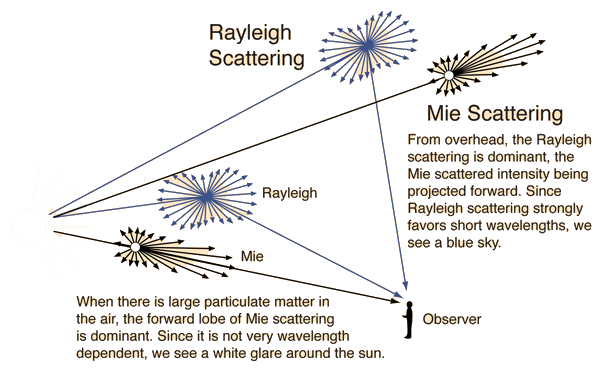JohnD wrote:You invoke anisotropy. Why should flat platelike particles be orientated with their flat faces sunward? Any irregularity, and light pressure or the Sun's wind would turn them edge on!
Nature invokes anisotropy, not i! Whereas larger particles are usually ellipsoids, particles smaller than 10 μm of soil and dust -as far as i know them- are usually plates, much less rounded than the larger particles. I think of them as similar in shape as glossy magazines. The reason for this (on earth) is the process of cristallisation, which is in favour for a flat layered structure. As far as i can read in my answer i did not mention alignment towards the sun. The phenomena with incident electro magnetic radiation (EMR) are not similar to light reflected by a mirror, so such an ideally aligned situation is not needed. The mathematical treatment of the relective and dispersive results of incident EMR is rather complicated and invokde -even for the most simple geometry of a particle- Bessel functions, which makes by back 'itch'. The problem was in the focus of the attention of the 19th centuries phycisists. Art Neuendorfer posted some references to Mie and Rayleigh scattering. To complete the spectrum, i'll add Raman scattering.
- Raman scattering is a process inwhich EMR is captured by the tiniest particles (e.g. molecules) and where EMR is emitted slightly later, in a different frequency. So a molecule might capture a blue photon and emitt a green photon, usually at a lower frequency. There is no preference for direction.
- Rayleigh scattering occurs when the fraction between diameter and wavelength is much smaller than 1. The intensity of the scattered EMR is strongly (quartic) dependent on its wavelength. As a result the intensity of blue light (400 nm) is 10 times stronger than that of the scattered red (700 nm) light. There is hardly a preference for direction. An example are tiny (airborne) particles in our atmosphere, which colour the sky blueish.
- Mie scattering occurs when particles are (substantially) larger than the wavelength of the incident EMR. There is hardly any dependence on wavelength. When sunlight is scattered by haze of tiny droplets in a cumulo nimbus cloud, the scattered light is white. There is some preference for a direction. The diagrams i see in Arts answers, resemble a simple Yagi antenna, a dipole with with one reflective element.
Raman scattering is the only item in this list which alters the wavelength. The change in frequency is continuous, virtually any wavelength can be emitted. In early 'tunable' laser systems Raman scattering was used to change the wavelength of the laser. Unfortunatedly the coherence of the light is lost. (There is no such thing as a free meal).
Rayleigh scattering produces partly polarised light. This phenomenen is known for at least a thousand years. In Denmark, Roskilde (pronouce roskeald) in the 1960 four large Viking ships were excavated in an artifical island in the bay (fjord). These ships were sunk a thousand years ago, in order to block the path for roaming Vikings which regularly plundered the city. On board of these ships two small stones were found, natural cristals, which polarise light. During nautical and civilian dusk the captains of the ships could investigate the polarisation of the sky to navigate. These crystals were placed in a brass (copper?) mounting in the orientation which made North easily to be found.
John, you are right that the solar wind will blow small anisotropic particles in the direction of least friction: "edge on". For the scattered light (Rayleigh, Mie or Raman) that is of no importance.
On the web there are several sources for the calculation the intensity of the scattered light. On
this website a list of sources is compiled. The most promissing to me seemed to be the Ph. D of
Sylvain Lecler, who has assembled an archive file of Matlab code for the calculation of Mie scattering on multiple particles, including a graphical user interface and graphical presentation. Unfortunatedly a limitation of his sources is that the maximum distance between the particles is 30 wave lengths, which is for the interplanetary space fully 'overcrowded' . A minor disadvantage is that the entire program is in French, so it will not be so accessible for you. (I presume that you don't spreak French, maybe that is a prejudice, sri).
Most probably, Mie scattering is for Gegenschein the dominant phenomenon, regarding the size of the particles and observed colour of the scattered light. Where i do differ in opinion from Art Neufer is his approach of a phased array of antennae. Such a configuration would -it is true- explain the sharp area where the Gegenschein could be seen. By non linear phenomena, as found in a Synthesis Radio Telescope (SRT), e.g. Westerbork, or Jocelyn Bell arrays), the side lobes can be dimmed. However interplanetary particles are not carefully aligned as in a SRT, which leaves the resulting angular plot of the Mie intensity virtually unchanged, compared with the intensity diagram of just one particle.
Maybe Arts explanation of phased arrays is right if we combine light of those particles which are in the right position for non linear effects, whereas combination of light of those particles not in the right position, leads to a much lower intensity. It is up to you Art, to adress this point (if you like to do so)!

